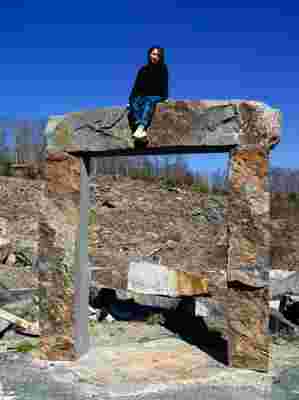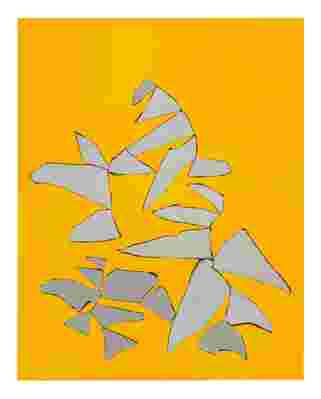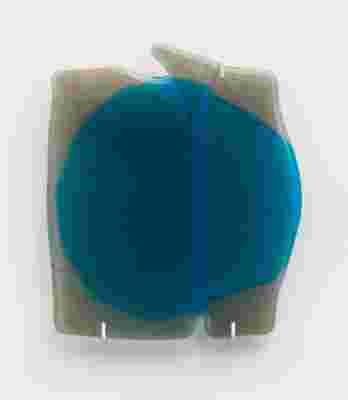Sam Moyer has long found energy where edges meet. “Bringing two things together, creating a vibration—that vibration is the art,” says the Brooklyn-based artist, best known for her mesmerizing compositions of shaped paintings and jagged stone pieces, which she fits together tightly like puzzle pieces. Now, in collaboration with Public Art Fund, Moyer is generating that same creative friction on an urban scale. On September 16, she’ll unveil a monumental new work on Doris C. Freedman Plaza, at the southeast corner of Central Park. Comprising three portals, each fitted with a door, the installation both finds and creates meaning at the intersection of two worlds.

Sam Moyer at a Pennsylvania quarry atop one of three stone portals she is creating for her Public Art Fund project.
“It’s this place where the industrial matter that is Manhattan ends and a controlled but natural environment begins,” explains Moyer, who quickly became interested in revolving doors while generating ideas for the site. (Support for the project comes from a number of individuals and groups, including Sean Kelly Gallery.) “I wanted to create something that was a transition between those two spaces but also echoed them, marrying a physical representation of the city and a physical representation of the park.”
In homage to local nature, the arches themselves are built from large hunks of indigenous granite, quarried not far from the city. The doors, on the other hand, feature her signature stone remnants, all leftover from countertops, lobbies, and other hallmarks of the built Big Apple. She mapped these out on her studio floor before having them set in massive concrete pours. “Often when you work at this scale, there’s no way for you as the artist to be involved with the production physically,” reflects Moyer. “I’ve enabled this so that I’m making a very large portion of the sculptures myself.”

S un on Sunset, 2019
The remnants themselves spark conversations about inclusivity, globalization, privilege, and politics at a time when the world feels particularly fragile. “These stones all come from different places and connect us to different cultural identities,” she says. “New York is this amazing place, which despite many hostilities and complications has historically been a haven for immigration.” Viewers, of course, can enjoy the installation at face value, passing through the fixed doors and weaving among the portals, a kind of cosmopolitan Stonehenge. “There’s this brilliant connection between the local and the global, but because of its abstract quality the work doesn’t prescribe a specific meaning,” says Public Art Fund curator Daniel S. Palmer. Though, as Moyer notes, it’s hard to resist the hopefulness of an open door. “I am trying to hold on to what’s good right now. Public art is good; public parks are good. In general, I am an optimist.”

Small Bond No. XL, 2019.